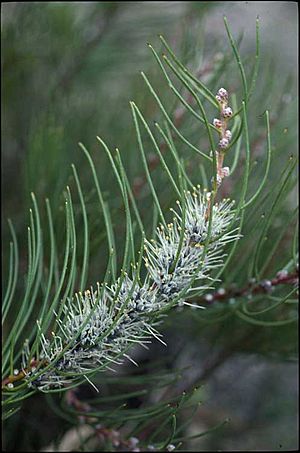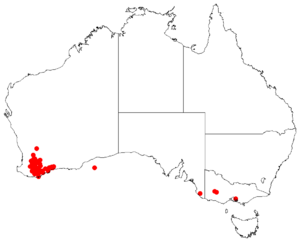Blue hakea facts for kids
Quick facts for kids Blue hakea |
|
|---|---|
 |
|
| Hakea lehmanniana (cultivated) | |
| Scientific classification | |
| Genus: |
Hakea
|
| Species: |
lehmanniana
|
 |
|
| Occurrence data from AVH | |
The Blue Hakea (Hakea lehmanniana) is a special type of shrub. It belongs to the Proteaceae plant family. This plant is known for its spiky, needle-like leaves and pretty blue flowers. You can see these flowers during the winter months. The Blue Hakea grows only in certain parts of Western Australia, specifically in the southern Wheatbelt and Great Southern regions. This means it is endemic to that area.
Contents
What Does Blue Hakea Look Like?
The Blue Hakea is a prickly, bushy shrub. It usually grows to be about 0.6 to 1.8 meters (2 to 6 feet) tall. This plant does not form a special woody lump at its base called a lignotuber.
Its flowers are very attractive. They bloom from June to August. The flowers are purple-blue at first, then fade to blue or white. They grow in thick bunches near the leaves.
The leaves of the Blue Hakea are smooth and hairless. They are round and thin, like needles. Each leaf is about 2 to 7 centimeters (0.8 to 2.8 inches) long and 1 to 2 millimeters (0.04 to 0.08 inches) thick. They end in a sharp point.
The fruit of the Blue Hakea is also unique. It is a 3D shape, about 2 to 3 centimeters (0.8 to 1.2 inches) long and 1.5 to 2 centimeters (0.6 to 0.8 inches) wide. The surface of the fruit is very rough and prickly. This rough fruit helps to identify this specific plant.
Where Does Blue Hakea Grow?
The Blue Hakea grows in Western Australia. You can find it from Pingelly in the north, stretching south to Albany, and east to Ravensthorpe.
This plant likes to grow in areas with heath or shrubland. It prefers gravelly-loam, sand, or sand over laterite soil. It can grow well in sunny spots or in places with some shade. The Blue Hakea is a tough plant. It can handle both frost and dry weather. Because it is so adaptable, it can be used as a ground cover plant. It also provides a good home for wildlife.
How Did Blue Hakea Get Its Name?
The scientific name for Blue Hakea, Hakea lehmanniana, was first officially described in 1845. A Swiss botanist named Carl Meisner wrote the description. It was published in a book called Plantae Preissianae.
The species was named to honor a German botanist, Johann Georg Christian Lehmann.
Is Blue Hakea Endangered?
No, the Blue Hakea is not in danger. The Western Australian Government has classified Hakea lehmanniana as "not threatened." This means there are plenty of these plants in the wild.

